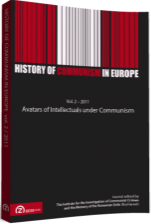Artists and Political Power: The Functioning of the Romanian Artists’ Union during the Ceauşescu Era, 1965-1975
Artists and Political Power: The Functioning of the Romanian Artists’ Union during the Ceauşescu Era, 1965-1975
Author(s): Alice MocănescuSubject(s): History
Published by: Zeta Books
Keywords: artists; political power; Uniunea Artiştilor Plastici (Romanian Artists’ Union); Union leadership
Summary/Abstract: This article explores the relationship between artists and the communist political power through a case study of the way in which Uniunea Artiştilor Plastici (Romanian Artists’ Union) functioned from 1965 to 1975. Based on the research at the Romanian Artists’ Union’s archive (Central Historical National Archives, Bucharest), this article seeks to map out the twisted and ambiguous relationship that developed between artists and the Ceauşescu regime, during a period of increased ideological pollution and scarcity of resources. Several issues will be addressed in this article. Firstly, it will look at artists’ reaction to the regime’s early attempts to win them over and to consolidate its power by using a mixture of captatio benevolentiae, persuasion and coercion techniques. More precisely, the article will look at how artists received and responded to the overt use of nationalist discourse in the field of fine arts, the augmentation of acquisition funds and the diversification of institutions involved in this process immediately after 1965. Secondly, this essay will explore the actual tools and mechanisms used by the Ceauşescu leadership to mold art production in line with the State’s cultural policy. More precisely, starting in the 1970s, the stricter ideological control and the cuts in funding led to deep transformations inside the Union. This line of investigation will analyze the new policy for exhibition, the requirements and making of thematic exhibitions, distribution of funds or of other advantages (loans, personal exhibitions, trips abroad, etc), which contributed to a polarization of the Union’s members and to an increased competition for limited resources. Thirdly, the article will look into the transformation of the Union’s leadership into an elitist body that started to monopolize resources and distribution of “privileges”, a practice that ultimately led to vocal protests from rank and the members of the Union.
Journal: History of Communism in Europe
- Issue Year: 2011
- Issue No: 2
- Page Range: 95-122
- Page Count: 28
- Language: English
- Content File-PDF

